|
|
Post by Penguin45 on Feb 26, 2012 21:48:00 GMT
Well, it took most of the day, but the head is now off. I assume that the problem was no. 3 stud at the front of the engine. In the end, I managed to remove some more of the head studs and took the valve rocker gear off altogether. This allowed a little more "wiggle" and the head finally came away. 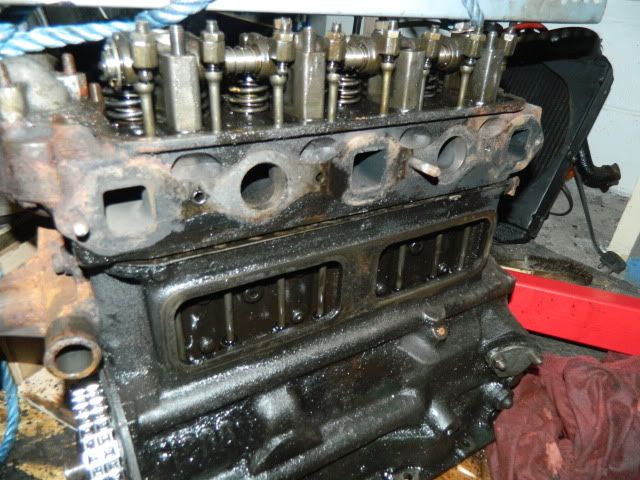  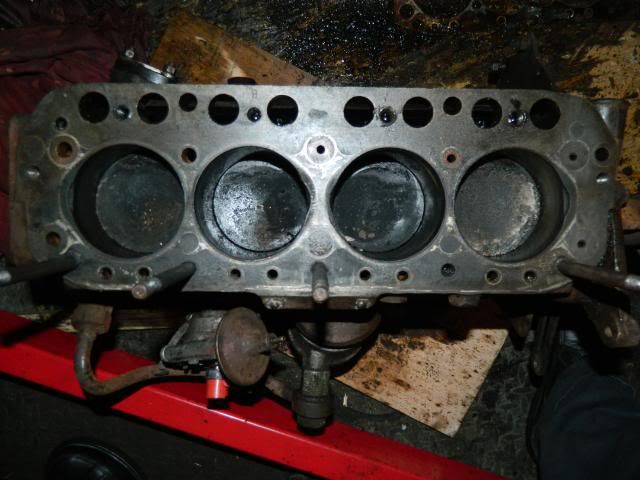 Looking into the cylinders shows some heavily carbonised piston tops. The bores themselves look completely smooth and unscored. There is a slight step at the top, which I can feel with my fingernail. Might not be too bad. 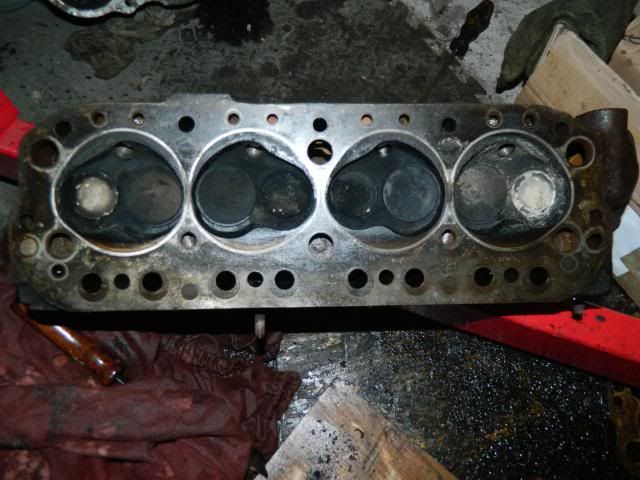 Cylinder head looks like it's been running a mix of rich and lean. I'll get this cleaned up in the week and see how it looks. 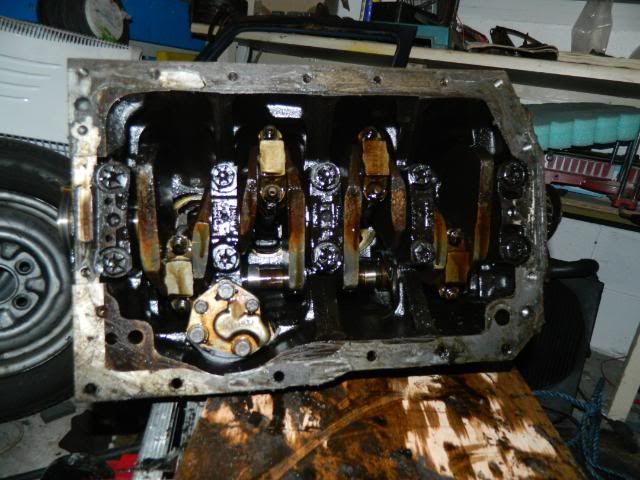 Bottom end. Haven't touched anything here yet, beyond checking for end float. Oddly, there doesn't seem to be any at all, which is clearly impossible. Pressing down the clutch pedal previously did lead to a slight drop in revs at idle. My mate Ady is calling down during the week, so we'll do some measuring and see what (if anything) needs to be done. Chris. |
|
|
|
Post by indianajones on Feb 26, 2012 22:25:33 GMT
More awesome photos, thanks again Chris. Have been looking at my workshop manuals and your other photos during the weekend and have decided that engines aren;t that scary after all.  -Andrew |
|
|
|
Post by Penguin45 on Feb 27, 2012 21:59:55 GMT
Patience, order, method, Indy. And, RTFM. ;D
Pistons and con rods now out. Three centre main bearing caps are out. The two end ones (1 + 5) need a special puller or a slide hammer. Slide hammer I have; just need to cook up something to pull on. The bearing cap has a 1/2" UNF tapped hole, so something that fits into that will be a good starting point. Oh, I need a 1 - 5/16" socket as well.
Plodding on. Actually, I need to get a bit of a wiggle on as Ady is supposed to be popping down later in the week with the precision measuring gear so we can check out what (if anything) needs to be done).
Chris.
|
|
|
|
Post by threelitre on Feb 28, 2012 11:37:14 GMT
I think the head and spark plugs look quite normal for a head running siamesed ports. I always get the same pattern on either A or B series. Maxi and C are better with indiviual ports for all cylinders.
Regards,
Alexander
|
|
|
|
Post by Penguin45 on Mar 1, 2012 1:31:15 GMT
I had hoped that the twin carb set-up would reduce the effect somewhat. This engine is at somewhere around 60k miles, but it's only done about 12k miles with the twin carburettor set-up. Also, this is the first time that the head has been off in my ownership. Nothing that a motorised wire brush can't deal with........ The crank is now ready to be removed. The stumbling block was no. 1 + 5 main bearing caps. The BOOK says to use the factory puller blah blah blah, which I don't have (and am unlikely to source) and my own pullers are too narrow to bridge the gap across the engine casing. I made this little chap: 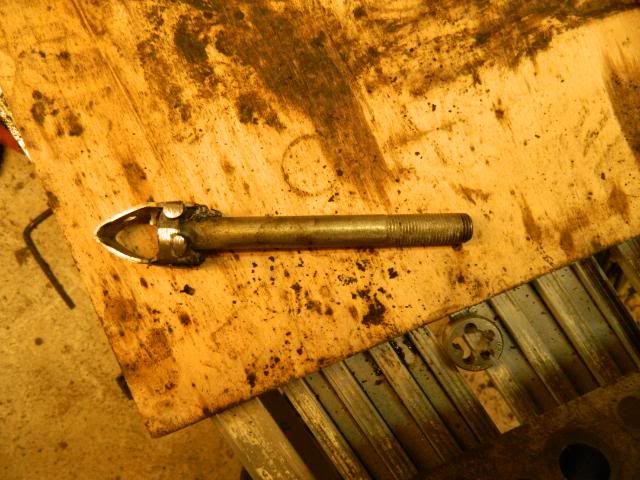 1/2" UNF bolt, with a heavy duty lug welded into a loop on the top. I took it once round the bench grinder to make it look slightly pretty..... 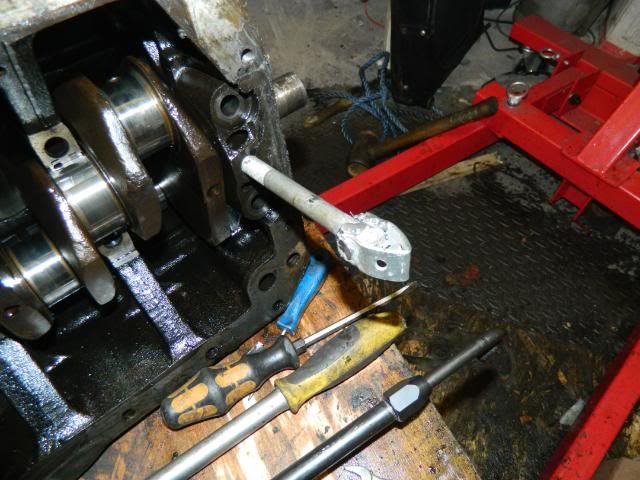 Strange to relate....... There's a 1/2" UNF hole tapped into the bearing cap. 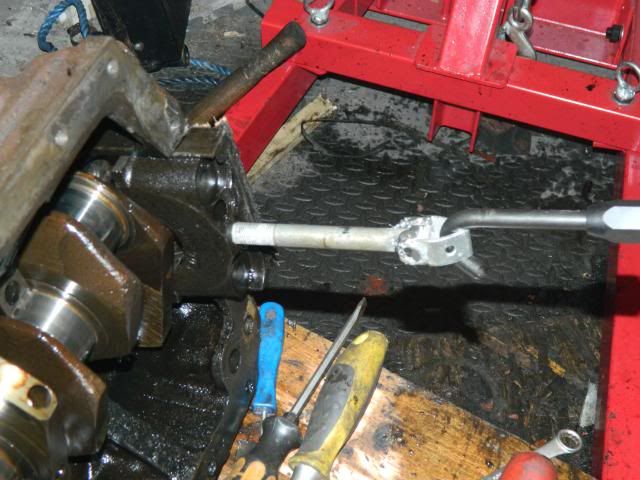 Slide hammer - three strokes and they both popped out, sweet as you like. Last pic is from our Nicholas, who I'm quite cetain had no idea about what he was taking pictures of. So that's it. Crank can be lifted out as required; Ady and I will get some serious measuring done over the next few days and then hopefully it can start going back together again. Chris. |
|
|
|
Post by Penguin45 on Mar 2, 2012 21:47:43 GMT
Bum.
We've finished measuring everything up and it's not all that good. Bores are very marginal at the top - they appear to have worn in a "wine glass" shape, so the top 1-1/2" has quite marked wear and ovality. Pot no. 1 is particularly bad.
Crank has minor wear, piston journal no. 4 and main journal no. 5 have minor scoring and are fractionally under tolerance.
In theory, we could re-ring and re-shell it and it would probably be fine for a good while. The correct solution is a +.010" rebore and crank grind. The problem here is that that's about £300 of machining, plus a set of pistons, in addition to the £160 odd that I reckoned I'd be spending anyway. This is a bit of a budget buster right at the moment.
However.......... There's a Gold Seal engine over the road in the spare garage. Time to haul it out and re-commission it, me thinks. The current one can be dealt with later........
Chris.
|
|
|
|
Post by indianajones on Mar 2, 2012 23:44:07 GMT
Ahwell, it is a 40 + year old engine so no surprise there really.
Good on ya for waiting to do it properly, not point in doing a half-arse job if you want to keep the car for the long term
-Andrew
|
|
|
|
Post by Penguin45 on Mar 3, 2012 1:22:33 GMT
True. Annoying, though. As Ady pointed out, this isn't the cars original engine, so replacing it isn't a massive issue. Assuming that the Gold Seal is in fact a Gold Seal, as opposed to an engine painted gold, I might as well use the d@mn thing. It should effectively be a new engine, so a few tweaks, plenty of oil down the bores and a good clean up seems like a much cheaper option.
Oh, and I suppose I'll have to paint it frog green. Gold will look hideous.
Chris.
|
|
|
|
Post by dave1800 on Mar 3, 2012 9:39:34 GMT
Alexander Do you notice more of less variation between cylinders with twin carb set ups. In theory the variation is greater at high rpm and high loads, but I think that valve timing where the inlet valve closes quite early as on 1800 (but less so on 1800S/MGB) also contributes. Chris Did you change the cam to 1800S/ MGB specs when you fitted the twin SUs? I think the head and spark plugs look quite normal for a head running siamesed ports. I always get the same pattern on either A or B series. Maxi and C are better with indiviual ports for all cylinders. Regards, Alexander |
|
|
|
Post by Penguin45 on Mar 4, 2012 1:16:38 GMT
Chris Did you change the cam to 1800S/ MGB specs when you fitted the twin SUs? Nope, Mike was of the opinion that the standard MkIII cam was perfectly adequate for the job; indeed, MGB owners were bagging them for fitment to their own cars. Todays adventures involved recovering the gold painted engine from the spare garage over the road and lugging it into my garage. Nicky (#1 twin) and I shoved "Das Boot" (Theo's SAAB 900 Vert) out of the garage and loading up a wooden crate onto a sack barrow and getting it 100 yards back to the garage. A whole new meaning to the word "fun" which I hadn't previously encountered, I can assure you. The big question was, is this an old engine painted gold, or is it really a Gold Seal factory re-con engine? I bought this blind off eBay years and years ago, for the princely sum of £40 and a trip down to Nottinghamshire and back. 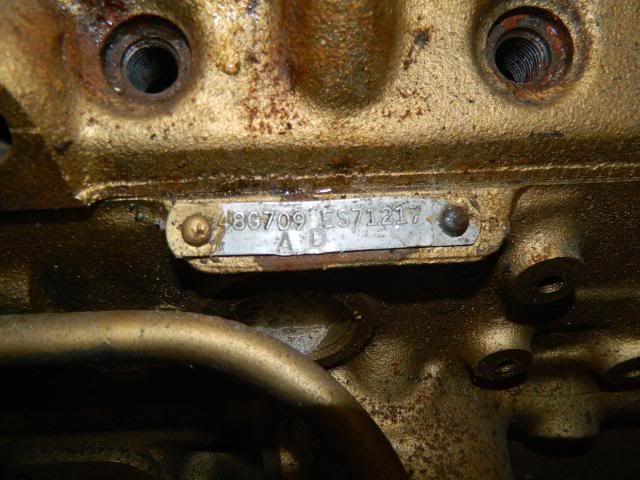 This is a good start - 48G code on the plate is a factory re-con number. 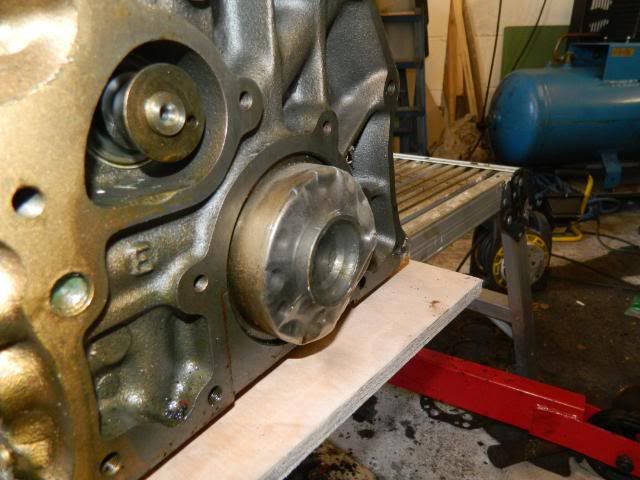 Plastic sheathing on the crank out put is also a good sign. 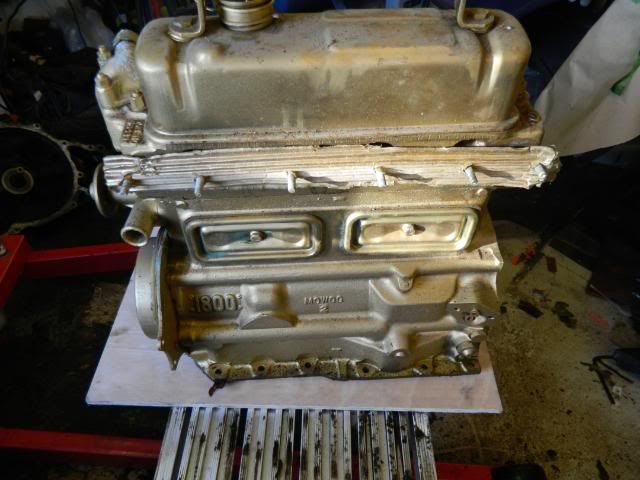 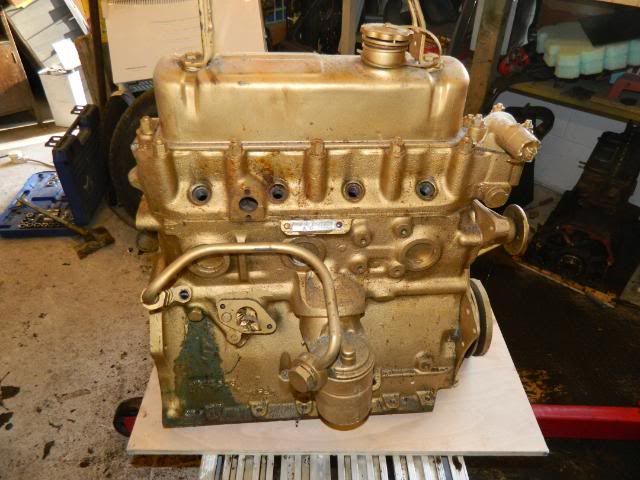 Various bits of "blanking" is also a good sign. You don't want gold paint inside the engine, do you? 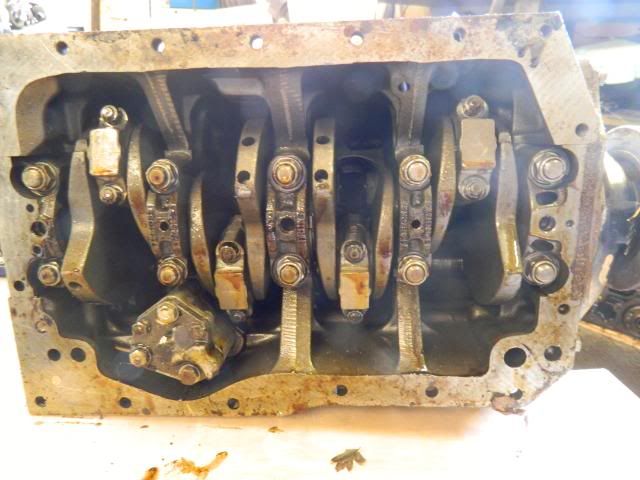 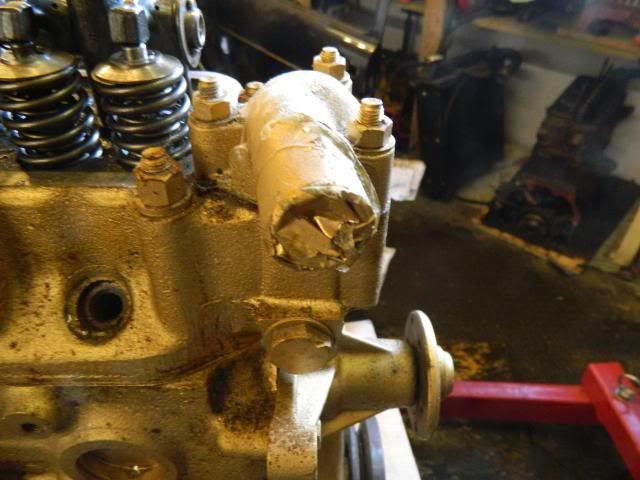 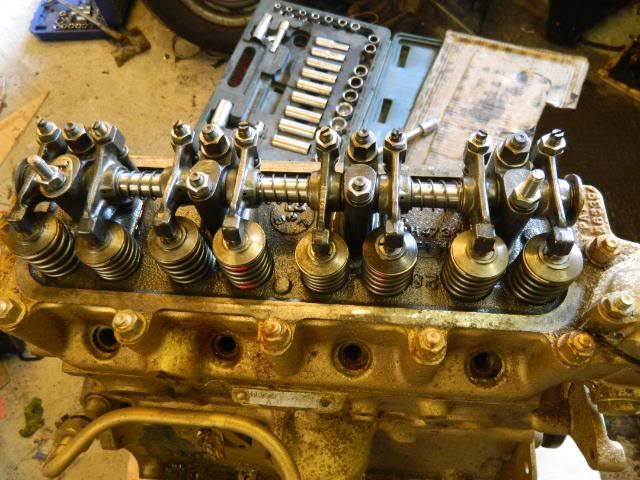 It's all good. As far as I can tell, all studs and fixings are new. Ady popped into have a poke about this afternoon and he is of the opinion that the valve guides are new, the pushrods are new.   It's been bored and honed, so new pistons; the head appears to have had a skim a well. The valve guides appear to have been replaced, so I suspect that we're on a winner. As you will have guessed, I pulled the head off to check the bores. I was surpirsed to find one of the old fibre head gaskets on it - it duly disintegrated and caused several hours work getting rid of the residue. It ahs now been replaced with a heavy duty copper reinforced on. Also the valves theselves were quite manky - took the drill and wire brush across them to clean them up. Additionally, I stripped the head and fitted the ST2001 valve stem seals which I got from America. 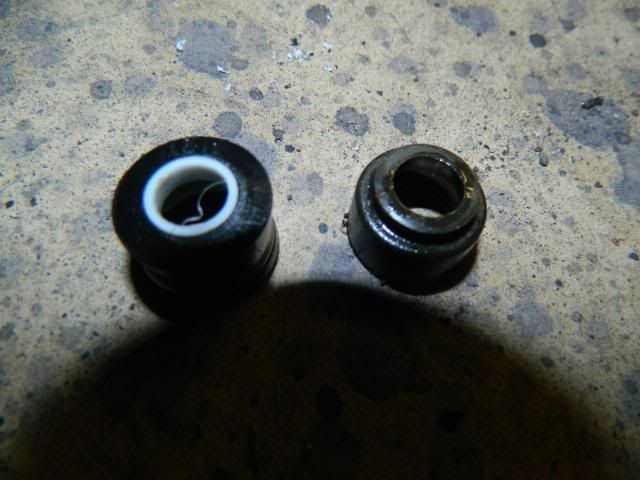 The one on the left is an ST2001. It has a Teflon insert; the body has a retaining spring for grip on the valve guide, so hopefully no smoke at idle. I was surprised to see the seal on the right - normally, it's a little "O" ring. These looked like the Ford Pinto seals, but there's no actual lip to make a mechanical seal, so I don't really know. So - just got to get a pot of Bronze Green engine enamel and paint the thing. There's no way that it's going back in the car looing like that. It's just possible that this is the best £40 ever spent! Chris. |
|
|
|
Post by Keef on Mar 4, 2012 1:25:18 GMT
It's just possible that this is the best £40 ever spent! Don't you love it when a plan comes together?  |
|
|
|
Post by indianajones on Mar 4, 2012 6:27:54 GMT
I wish I could get one of those for 40 pounds!
Looks good,. Might be worth the effort of me shipping one to NZ down the line. Are they easy to get a hold of?
-Andrew
|
|
|
|
Post by sherpa on Mar 4, 2012 8:02:22 GMT
So - just got to get a pot of Bronze Green engine enamel and paint the thing. There's no way that it's going back in the car looing like that. Phew, I was a bit concerned for a minute that it was going in gold. |
|
|
|
Post by tommydp on Mar 4, 2012 10:40:23 GMT
Oh, Chris I envy you that Gold seal engine! What a marvellous machine. It must have been a bargain at £40!
It has got to be a genuine gold seal, judging by the pictures. Oil that cork seal under the timing gear massively before putting it on the gearbox.
I once got hold of a Marina TC gold seal engine, but unfortunately I sold it as I needed the money back then. The chap who bought it was going to fit it to an MGB. I told him he would not be able to fit the MGB gearbox, as the marina has a smaller diameter hole in the crank for the gearbox shaft, but he didn't care..
I regret I sold it, as I would love to have spare Gold seal engines for the Marina as well as the 1800, if I could get one:-)
If anyone knows about the whereabouts of a Gold seal engine for the 1800 Crab, I'll pay a nice amount of money for it and arrange collection even if I have to row across the North Sea to get it:-)
Good luck Chris! I really enjoy your frequent updates and photos! I'm not very active myself these days, but will return later with photos an d updates. At least I've managed to get the Rover roadworthy. I'ts a marvellous car, for very little money:-)
Regards, Tommy:-)
|
|
|
|
Post by kelsham on Mar 4, 2012 11:36:28 GMT
I bought one of the ex M.O.D. engines a few years back. They were built with low compression pistons.
After 30,000 miles the valve seats needed attention, probably due to unleaded petrol.
I decided to remove the engine and fit higher compression pistons, I was astonished to find that when I stripped the crank,one of the rods showed wear on the sides of the shells.
I came to the conclusion the engine had suffered a big end failure and been rebuilt without checking the rod.
It had been hammered oval.
The engine must have been very tight when rebuilt as the sides of the shells were down to the backing material. It should have been picked up at this point.
i fitted higher compression pistons, new rods, and hardened valve seats, I also found a recon distributor on Ebay with the correct advance.
Took the old girl out last week and she flew. My point is to be sure do the rebuild yourself, or check the engine you buy thoroughly before you install it.
Regards Kels
|
|

























